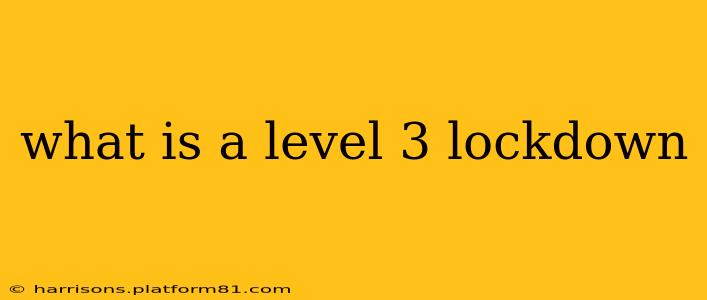A "Level 3 lockdown" isn't a universally standardized term. The specific restrictions associated with a Level 3 lockdown vary significantly depending on the country, region, or even the specific organization implementing it (e.g., a school, workplace, or event). There's no single, globally recognized definition. However, we can explore the general characteristics and understand what to expect based on common interpretations. Think of it as a spectrum rather than a precise definition.
A Level 3 lockdown typically represents a more stringent set of restrictions than a Level 1 or Level 2, but less severe than a complete (Level 4 or full) lockdown. It's often implemented as a preventative measure or in response to a developing situation, such as a surge in a contagious illness or a security threat.
What Restrictions Might Be in Place During a Level 3 Lockdown?
The restrictions imposed during a Level 3 lockdown might include a combination of the following:
-
Movement Restrictions: Curfews might be implemented, limiting movement during certain hours. Travel might be restricted within a region or across borders. Non-essential travel may be strongly discouraged.
-
Business Closures: Non-essential businesses and services might be ordered to close or operate with reduced capacity. Essential businesses, such as grocery stores and pharmacies, typically remain open, but with potential restrictions on operating hours or customer numbers.
-
Social Gathering Limitations: Restrictions on public gatherings might be in place, limiting the number of people allowed to assemble in one location. Social distancing measures would likely be strongly enforced.
-
Workplace Adjustments: Many businesses might switch to remote work arrangements if possible. Those requiring in-person work might implement stricter safety protocols, such as mandatory mask-wearing and enhanced hygiene measures.
-
School Closures: Schools might be temporarily closed, shifting to online learning. This would be more likely during a higher-level threat or in cases where the virus's spread affects the student population.
-
Public Transportation: Public transportation might operate with reduced capacity or altered schedules.
What are the Differences Between Lockdown Levels?
The specific differences between lockdown levels (e.g., Level 1, Level 2, Level 3) aren't consistently defined across jurisdictions. It's crucial to consult official government sources or local announcements for accurate, up-to-date information for your specific area. One region's Level 3 might be another's Level 2, depending on the severity of the situation and the government's response.
How Do I Find Out About Lockdown Levels in My Area?
The best way to get up-to-date information on lockdown levels and restrictions in your specific area is to check official government websites, public health agencies, and local news sources. Be wary of unverified information from social media.
What if a Level 3 Lockdown is Implemented Where I Live?
Being prepared is crucial. Stock up on essential supplies, create a communication plan with family and friends, and familiarize yourself with local emergency services.
Remember: The specific implications of a Level 3 lockdown are highly contextual. Always refer to official sources for accurate and timely information.
